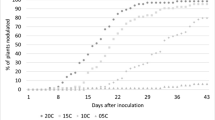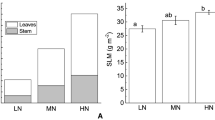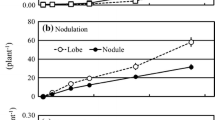Summary
Lotus tenuis was inoculated withRhizobium spp. and grown at three different night temperatures (17, 21 and 27°C) and at two different photoperiods for each temperature: short days (SD) of 8-h light and long days (LD) of 16-h light. Night temperature exerted a stronger effect on dry-matter partitioning than of total dry-matter accumulation. Leaf area increased under LD though less N per leaf area was found. A greater number of leaves under SD might be linked to a day-length effect upon apical dominance and hence on branching, thus resulting in a greater crown growth. Nodulation and nitrogen fixation was greater under SD though specific nodule activity was the same regardless of the environmental conditions of growth. It can be concluded that the best planting time forLotus tenuis would be in the autumn when the days are shortening and the temperature is lower.
Résumé
Lotus tenuis a été inoculé avecRhizobium spp. et mis à croître aux trois températures nocturnes, de 17, 21, et 27°C et à deux photo-périodes pour chaque température: des jours courts (SD) de 8 heures de lumière et des jours longs (LD) de 16 heures de lumière. La température nocturne exerce un effet davantage marqué sur la répartition de la matière sèche que sur l'accumulation totale de la matière sèche. La surface foliaire augmente dans le cas des LD bien que l'on trouve moins d'azote par unité de surface foliaire. Dans le cas des SD, de plus grands nombres de feuilles pourraient être liés à un effet de longueur de jours sous dominance apicale, c'est-à-dire en banchement, résultant donc dans la croissance d'une plus grande couronne. La nodulation et la fixation d'azote sont plus grandes dans le cas des SD bien que l'activité spécifique des nodules soit la même, indépendamment des conditions environnementales de croissance. On peut en conclure que le meileur moment de plantation pourLotus tenuis serait l'automne lorsque les jours raccourcissent et que la température est plus basse.
Similar content being viewed by others
References
Balatti, P. A. &Montaldi, E. R. 1983 Efecto del fotoperiodo sobre la nodulación y fijación de nitrógeno atmosferico en plantas de soja.Revista de la Facultad de Agronomía U.N.L.P. 57, 23–29.
Balatti, P. A. &Montaldi, E. R. 1986 Effects of red and far red lights on nodulation and nitrogen fixation in soybean (Glycine max L. Merr).Plant and Soil 92, 427–430.
Casano, L. M., Valle, E. M., Morandi, E. N. &Nakayama, F. 1984 Ribulose-biphosphate carboxylase activity of soybean (Glycine max L. Merr) leaves under different photoperiods.Photosynthetica 18, 42–45.
Comstock, J. &Ehleringer, J. R. 1986 Photoperiod and photosynthetic capacity inLotus scoparius.Plant Cell and Environment 9, 609–612.
Guiamet, J. J., Balatti, P. A. &Montaldi, E. R. 1986 Nitrogen assimilation and leaf development in indeterminate soybeans as influenced by post-flowering photoperiod.Journal of Experimental Botany 37, 1611–1618.
Henson, R. A. &Heichel, G. H. 1984 Partitioning of symbiotically fixed nitrogen in soybeans and alfalfa.Crop Science 24, 986–990.
Huxley, P. A. &Summerfield, J. R. 1974 Effect of night temperature and photoperiod on the reproductive ontogeny of cultivars of cowpea and of soybeans selected for the wet tropics.Plant Science Letters 3, 11–17.
Lopreto, C. R., Mazza, L. A. &Balatti, A. P. 1973 Producción de inoculantes para soja.Revista de la Facultad de Agronomía U.N.L.P. 49, 201–230.
Majid, S. &Jolliff, G. D. 1984a Effects of night temperature on dry matter partitioning and seed growth of indeterminate field-grown soybeans.Crop Science 24, 704–710.
Majid, S. &Jolliff, G. D. 1984b Physiological responses of field-grown soybean leaves to increased reproductive load induced by elevated night temperatures.Crop Science 24, 952–957.
Majid, S. &Jolliff, G. D. 1984c Night temperature effects on morphology, phenology yield and yield components of indeterminate field-grown soybeans.Agronomy Journal 76, 824–828.
Mes, M. 1959 Influence of gibberellic acid on the growth, flowering, nodulation and nitrogen assimilation ofVicia villosa.Nature (London) 184, 2035–2036.
Mes, M. 1960 Influence of temperature on the symbiotic nitrogen fixation of legumes.Nature (London) 184, 2032.
Meyer, D. R. &Anderson, D. J. 1959 Temperature and symbiotic nitrogen fixation.Nature (London) 183, 61.
Minchin, F. R. &Pate, J. S. 1974 Diurnal functioning of the legume root nodule.Journal of Experimental Botany 25 N, 295–308.
Morgan, D. C. &Smith, H. 1981 Non-photosynthetic responses to light quality. InEncyclopedia of Plant Physiology, eds. Lange, O. L., Nobel, P. S., Osmond, C. B. and Ziegler, H. Vol. 16B, pp. 109–134. Berlin, Heidelberg, New York: Springer Verlag.
Ogg, C. L. 1960 Determination of nitrogen by the micro-Kjeldahl method.Journal Association Official Agricultural Chemistry 43, 689–93.
Parker, M. W. &Borthwick, H. A. 1943 Influence of temperature on photoperiod reactions in leaf blades of biloxi soybean.Botanical Gazette 104, 612–619.
Salisbury, F. B. 1981 Responses to photoperiod InEncyclopedia of Plant Physiology, eds. Lange, O. L., Nobel, P. S., Osmond, C. B. and Ziegler, H. Vol. 12A, pp. 135–162. Berlin, Heidelberg, New York: Springer-Verlag.
Thomas, J. F. &Raper, C. D. Jr. 1977 Morphological response of soybeans as governed by photoperiod, temperature and age at treatment.Botanical Gazette 138, 321–328.
Author information
Authors and Affiliations
Rights and permissions
About this article
Cite this article
Balatti, P.A., Giménez, D.O. Effect of night temperature and photoperiod on growth, nodulation and nitrogen fixation inLotus tenuis . World J Microbiol Biotechnol 5, 161–167 (1989). https://doi.org/10.1007/BF01741839
Received:
Accepted:
Issue Date:
DOI: https://doi.org/10.1007/BF01741839




